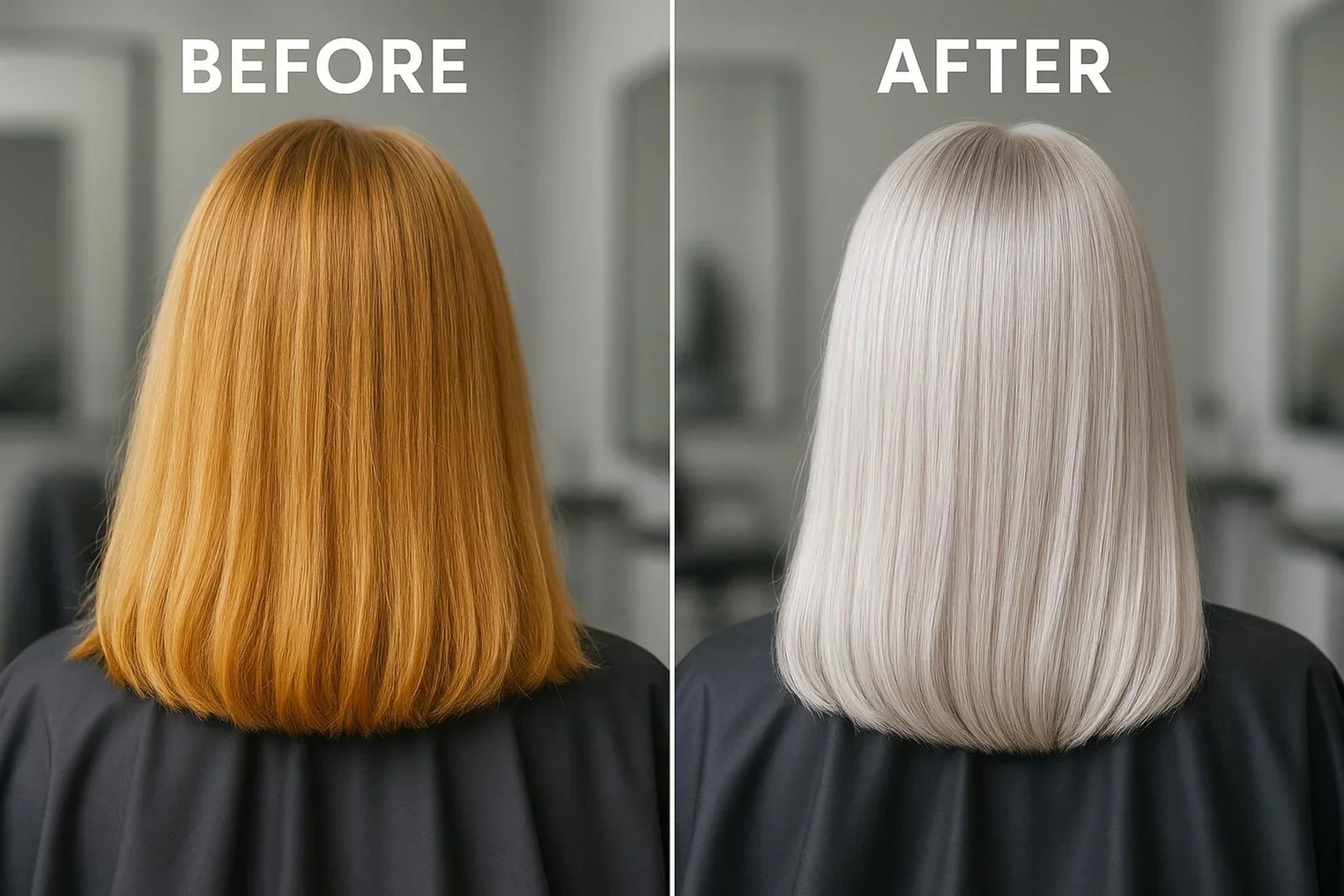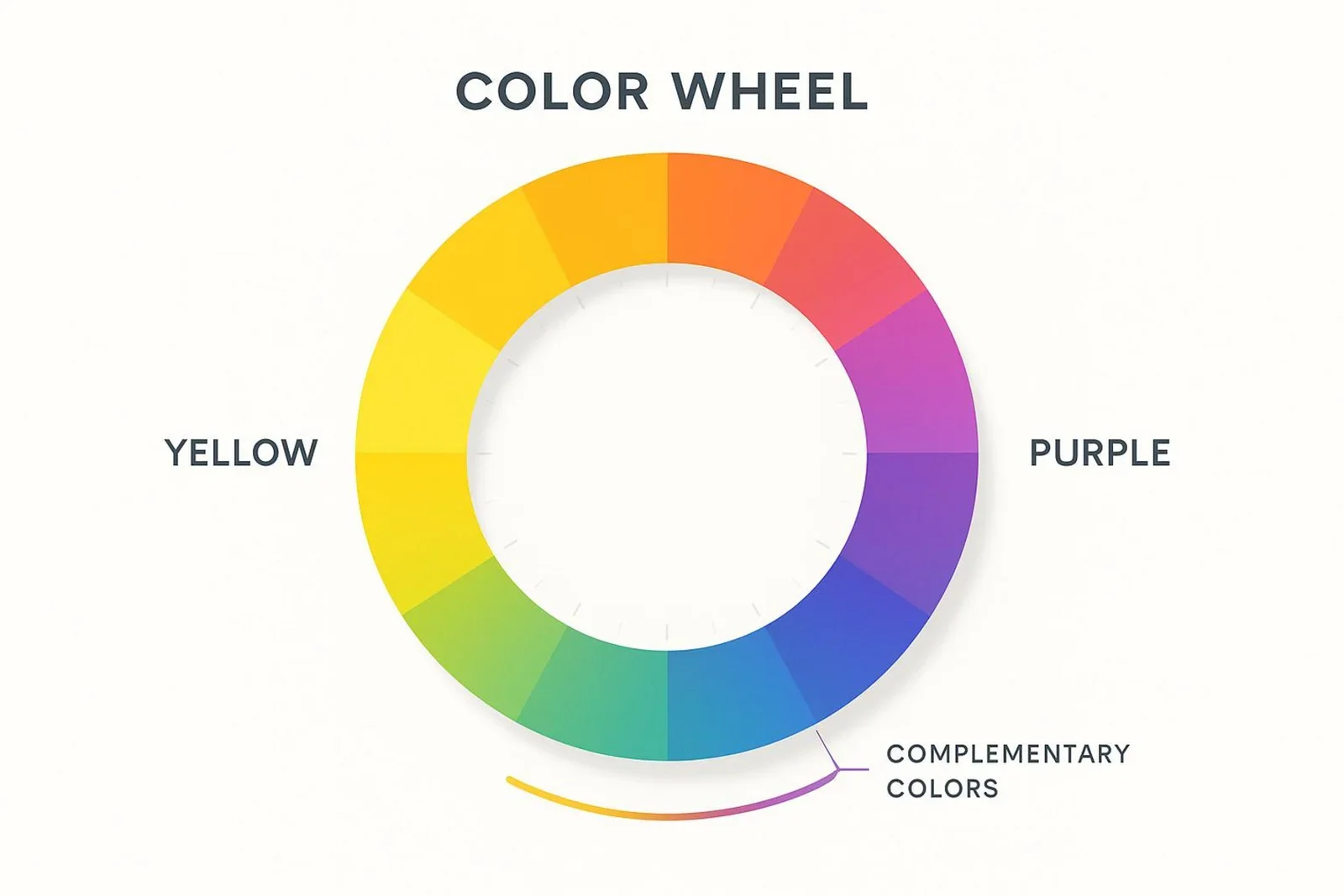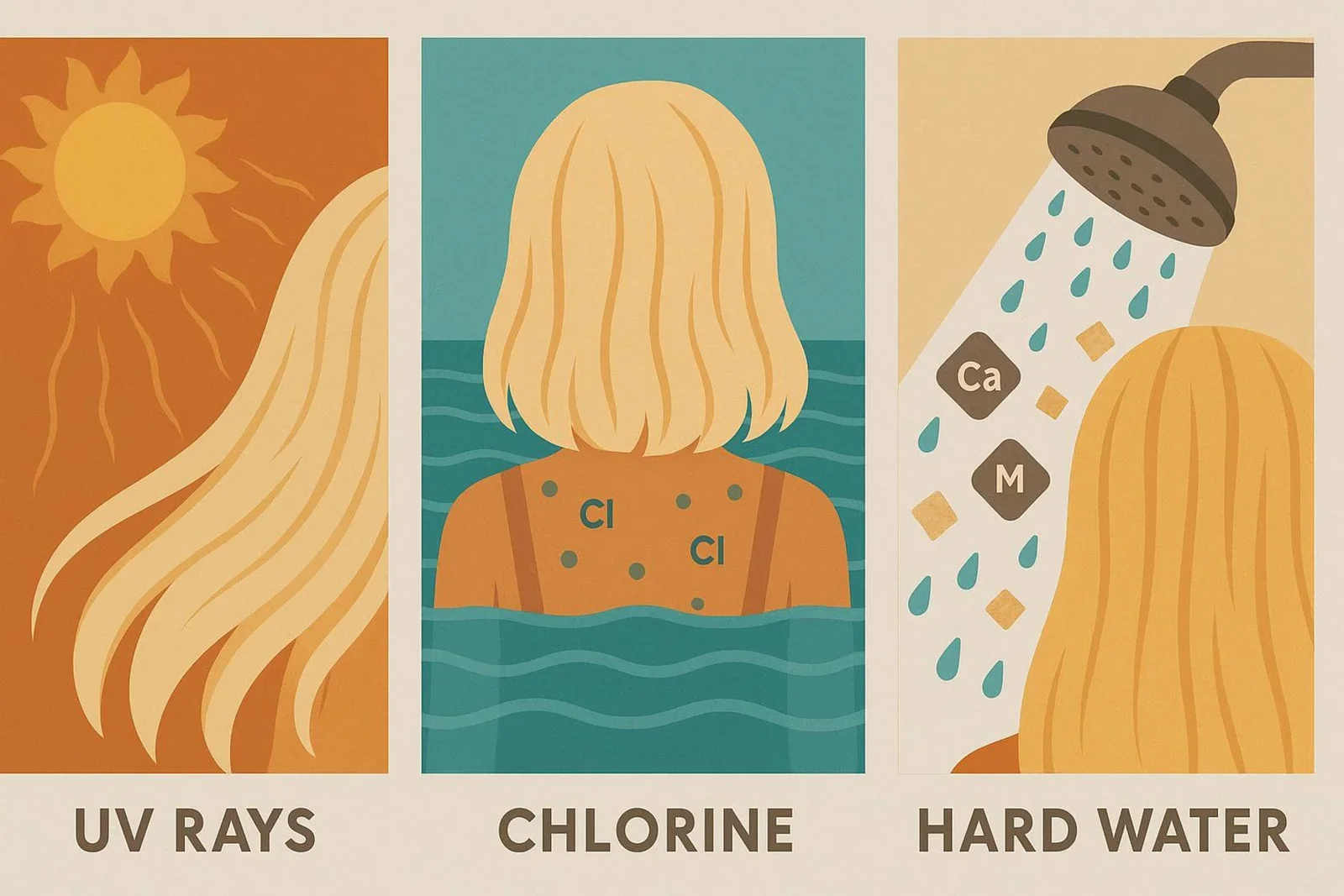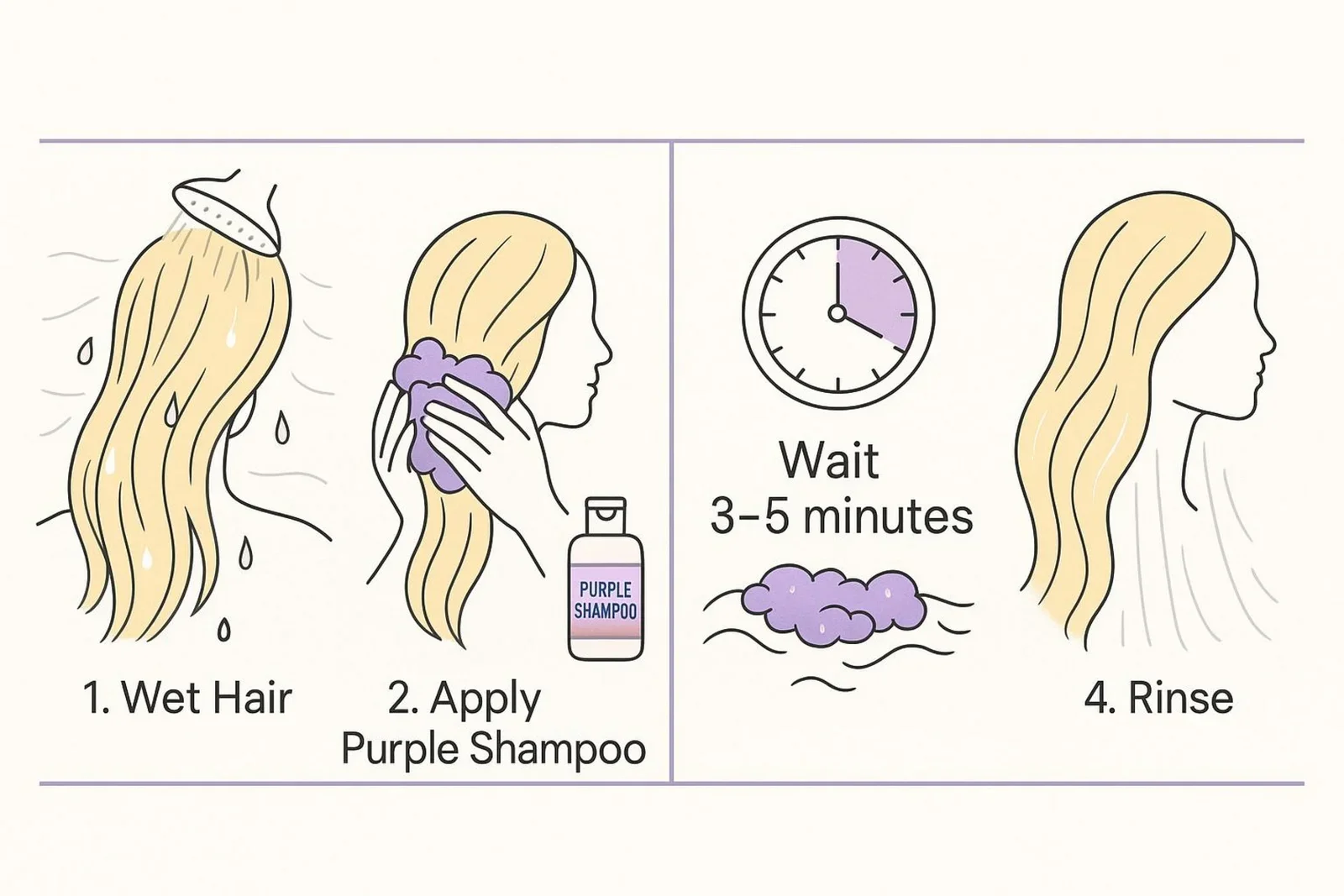What Does Purple Shampoo Really Do? The Truth About Toning
Let’s keep it simple. Purple shampoo helps keep blonde, silver, or lightened hair looking cool and bright by cancelling yellow and brassy tones. It doesn’t lighten hair and it isn’t permanent. Think of it as a short-term “filter” or an at-home toner, made to balance warmth and keep a cool finish between salon visits.
It’s become very popular as more people care for their colour at home. But using it the right way matters if you want great results without surprises. Let’s take a clear look at purple shampoo and what it really does for your tone.
How Does Purple Shampoo Differ from Regular Shampoo?
Purple shampoo might look like a normal shampoo with a bold colour, but it does more than cleanse. Regular shampoos mainly wash away dirt, oil, and buildup. They may add moisture or protect colour, but they don’t change your hair’s tone.
Purple shampoo is a cleanser with violet pigments. These pigments coat the hair and help correct colour by reducing yellow and gold tones in lightened hair. It’s a targeted toning step, while your daily shampoo is more of an all-round cleaner.
| Feature | Regular Shampoo | Purple Shampoo |
|---|---|---|
| Main purpose | Cleanse hair and scalp | Cleanse and tone |
| Pigments | None or minimal | Violet pigments |
| Effect on tone | No colour change | Neutralises yellow/brass |
| Best for | Any hair type | Blonde, silver, or lightened hair |
Who Can Benefit Most from Purple Shampoo?
It’s not just for platinum blondes. Anyone with lightened hair that picks up yellow or brassy tones can use purple shampoo. That includes classic blondes, icy platinum, and silver hair, which can turn yellow over time.
It also helps if you have highlights, balayage, or lighter pieces in brown hair. It keeps those sections fresh-looking. People with pastel or “unicorn” shades (especially cool tones like purple or blue) can also use it to help keep their colour from drifting warm. In short, if you want any lightened parts to stay cool and bright, purple shampoo can help.
Why Is Purple Shampoo Purple? The Science Behind Toning
Why purple? It’s all about basic colour theory, not just looks. The colour wheel explains why this works so well outside the shower too.
On the colour wheel, purple sits opposite yellow. Understanding that simple idea explains why purple shampoo cuts brass so well.
How Does Colour Theory Prevent Brassiness?
On the wheel, colours that sit opposite each other are complementary. Purple sits opposite yellow. When mixed, complementary colours cancel each other out.
So when the violet pigments touch yellow tones in your hair, they reduce them. This cools the hair and brings it closer to an ashy finish. It’s the same idea your colourist uses with a salon toner to perfect your shade.
What Are the Key Ingredients in Purple Shampoo?
Besides violet pigments, many purple shampoos include ingredients that care for lightened hair. Lightening can weaken hair, so many quality formulas do more than tone.
For example, Redken Blondage uses a Triple Acid Protein complex. It includes amino acids to support the hair’s protein, helping the strand feel stronger. Citric acid helps bring hair back to a healthy pH, which smooths the cuticle for more shine. Maleic acid helps support internal bonds, which can reduce breakage. Wheat protein can add conditioning and strength, improve elasticity, and limit porosity for better moisture and colour hold. Together, these ingredients neutralise brass and help your hair look and feel healthier.
What Causes Brassiness in Blonde and Lightened Hair?
Brassiness is that warm yellow or orange tint that creeps into lightened hair. It happens for many reasons, both inside the hair and from outside factors.
Knowing the causes helps you protect your colour and see why at-home toning helps so much.
Environmental Factors That Lead to Yellow Tones
Weather and water can speed up fading and brass. Sunlight is a big one. UV rays break down colour molecules, showing the warm tones underneath.
Chlorine in pools can push hair warm or even greenish in some cases. Saltwater can dry hair and fade colour, which brings back warmth. Hard water minerals can also build up and leave hair looking dull and brassy. These daily factors work against a cool blonde, so at-home toning is a helpful shield.
How Hair Treatments and Styling Affect Colour
Lightening exposes the red, orange, and yellow tones that live in hair. A salon toner (like Redken Shades EQ Gloss) reduces those tones to reach your target shade. That toner fades over time, and the warmth returns.
Heat styling can speed this up. High heat from dryers, straighteners, and curlers can push hair warmer. Product buildup can dull colour too. Some treatments can change how well colour holds. It takes steady care, but you can slow brass with the right steps.
How Does Purple Shampoo Tone Hair?
Purple shampoo works by placing violet pigments on the hair to balance yellow. How you use it matters.
It’s like a mini toner you can do at home to keep your blonde on track between salon visits.
Step-by-Step: How to Use Purple Shampoo Effectively
Good toning comes down to method and timing. Follow these steps to get results without a purple cast:
Wet Your Hair Thoroughly: Soak your hair well. This helps even spread of the shampoo.
Pre-Cleanse if Needed: If hair feels oily or loaded with product, do a quick wash with your usual colour-safe shampoo. Applying purple shampoo to clean hair helps the pigment grab better.
Apply the Purple Shampoo: Use enough product to coat your hair. Lather lightly, then work it through. Focus on the brassiest areas, usually mid-lengths and ends. Make sure all warm areas are covered.
Lather and Wait: Work up a lather to spread the pigment. Now comes the key part: let it sit.
Rinse Thoroughly: When time is up, rinse very well. Keep going until the water runs clear with no purple left on hair or scalp.
Condition: Follow with a good colour-safe conditioner or a purple mask. Purple shampoos can feel drying, so adding moisture helps keep hair soft and smooth.
How Long Should You Leave Purple Shampoo On?
Timing varies by hair type, how brassy you are, and the product you use. As a rough guide, 1-2 minutes works for a light refresh. For stronger toning, try 3-5 minutes. Some products suggest longer, but it’s smart to start short.
Always follow the instructions on the bottle. Watch your tone the first few times you use a new product. It’s easier to add more toning next wash than to remove too much.
What Happens If You Leave It On Too Long?
If you forget and leave it on too long, don’t stress. Purple shampoo won’t permanently dye your hair. But it can leave a mild lavender or silvery-blue tint, and make blonde look a bit darker or dull.
If this happens, rinse right away. Use a clarifying shampoo at your next wash to lift extra pigment. Next time, shorten the time, then build up as needed until you find your sweet spot.
How Often Should You Use Purple Shampoo?
How often you use it depends on your hair and how fast brass shows up. There is no one rule for everyone.
Use it too often and your colour can look flat, muddy, or slightly purple. Finding the right rhythm is very important for a bright, cool finish.
How Hair Type and Colour Affect Frequency
Most blondes who want a cool tone do well with purple shampoo about once a week. If you shampoo two to three times weekly, make one of those a purple wash to keep things clear without overdoing it.
If your hair is very porous, shorten the time to avoid over-toning. If your hair is low porosity, you may need a slightly longer leave-on time, but use it less often to avoid buildup. Brunettes with blonde highlights or balayage can use it every two weeks or as needed to tone the lighter pieces without changing the base.
Adjusting Use for Natural, Dyed, or Bleached Blondes
Dyed and bleached hair often gets brassy faster as the salon toner fades. A steady weekly purple shampoo can help, starting one to two weeks after your appointment, or as soon as you spot warmth.
Natural blondes can benefit too. Sun, hard water, and heat can warm up natural hair. Try purple shampoo a bit less often, or mix a small amount with your regular shampoo for gentle toning. Mixing is also helpful if you worry about over-toning or want to use purple shampoo more often without going too far.
What Are the Benefits and Potential Drawbacks of Purple Shampoo?
Purple shampoo can be very effective, but it has upsides and downsides. Knowing both helps you decide how it fits into your routine.
The goal is to keep a cool tone while keeping hair healthy and shiny.
Preventing Brassiness and Maintaining a Cooler Tone
The biggest benefit is how well it reduces brassiness. For blonde, silver, and lightened hair, yellow and orange tones are a common problem. Purple shampoo adds violet pigment that pushes those tones back, helping your colour look fresh and cool between salon visits. It can stretch the time between toning services.
It also helps keep shades like platinum, ash blonde, and silver from looking dull or yellow. If you like an ashy look, purple shampoo is a handy tool that lets you get that effect at home without extra chemicals.
Risks: Over-Toning, Dryness, and Possible Purple Tint
Most issues come from overuse. Leaving it on too long or using it too often can cause a faint purple tint or make blonde look darker or muddy.
Some purple shampoos feel drying, especially on hair that’s already stressed from lightening. This can lead to brittleness. Frequent use can also cause pigment buildup over time, making hair look greyish instead of bright. The trick is to use just enough to tone without staining.
Signs You’re Using Purple Shampoo Too Often
Your hair will tell you. If you see a lavender or silvery-blue tint, you’ve gone past neutralising and started depositing colour.
If your blonde looks dull, flat, or less shiny, or if your hair feels dry or rough, scale back your use or shorten the time. Less can give a cleaner, brighter result.
Alternatives and Complementary Products for Toning Hair
Purple shampoo is great for at-home toning, but other products and salon services can help too, depending on your hair and goals.
Building a well-rounded hair routine means knowing your options for keeping blonde at its best.
Is a Purple Hair Mask Necessary?
You don’t always need a purple mask, but it can be a very useful add-on. Think of it as a stronger, more caring partner to your shampoo. While purple shampoo cleans and tones, a purple mask gives deeper toning with extra moisture.
Products like Blond Absolu Ultra-Violet Hair Mask pair strong neutralisers with hydrating care. Many include ingredients like hyaluronic acid to hydrate and strengthen, and edelweiss to calm and soften sensitised hair. A weekly purple mask can be very helpful for dry or damaged hair, giving more pigment while adding moisture and repair.
When Should You See a Professional for Colour Correction?
If brass or unwanted tones don’t shift with at-home care, book a visit with a trusted colourist. When your colour isn’t where you want it, a salon colour correction can help.
This is a more detailed, custom service for uneven colour, stubborn warmth, or tones that are too light, dark, warm, or cool. A Redken stylist can use pro toners like Shades EQ Gloss to fix yellow, orange, or even bluish tones from overusing purple shampoo. It’s more advanced than home care and can reach results that store products can’t. Many salons also offer a quick 20-minute gloss between full colour visits to keep brass away.
Top Tips for Maintaining Bright, Toned Hair Between Salon Visits
Keeping blonde bright isn’t just about purple shampoo. You need an all-round routine, especially in sunny, harsh conditions.
Use these tips to keep your tone clean and your hair healthy.
Creating a Blonde-Friendly Haircare Routine
Start with quality, professional products. Cheap purple shampoos can be very drying. Choose formulas that tone and care for your hair. Look for sulfate-free shampoos and conditioners to protect colour. Lines like Redken Blondage or Davines Heart of Glass are made for blondes and offer toning, strength, and conditioning.
Always follow purple shampoo with a nourishing, colour-safe conditioner. Add a leave-in, like Acidic Bonding Concentrate, to support weak spots. If you use heat tools, a heat protectant is a must, since high heat can cause yellow tones. Use masks regularly-even non-purple ones-to keep moisture levels up, which helps colour last and look brighter.
Best Practices to Prevent Brassiness in Australian Conditions
Strong sun fades colour fast, so wear a hat during long outdoor time. If you swim in pools or the ocean, wet your hair with fresh water and apply a leave-in conditioner before you get in. This helps block chlorine and salt.
Hard water can drop minerals on your hair that cause brassiness. A shower filter can cut down on buildup. Turn the heat setting down on styling tools and always use heat protection. Trim regularly to keep ends healthy, since ends soak up warm tones more easily. With these habits plus smart toning, your blonde will stay bright even in tough conditions.
Final Thoughts: Is Purple Shampoo Right for Your Hair?
After looking closely at purple shampoo, it’s clear this product can be a very useful part of a blonde routine. It helps fight brass and keep a cool tone between salon visits. Still, it’s not the same for everyone, and small details matter.
If you’re unsure what to do for your hair type or shade, ask your hairdresser. They can give personal advice, check your hair’s porosity, and help you pick the right products and timing. Booking a chat with a blonde specialist can make a big difference. By understanding how purple shampoo works, using it the right way, and choosing formulas that also repair, you’ll be well prepared to keep your blonde clear, cool, and glowing-at the beach or out in the city.
Do you live in Sydney?
Get the perfect look at our salon – schedule your appointment now!
Our Services
Check Out Our Instagram
Check out our instagram
Check out our instagram and see our latest posts!
Check out our facebook
Check out our facebook and see our latest
posts!












